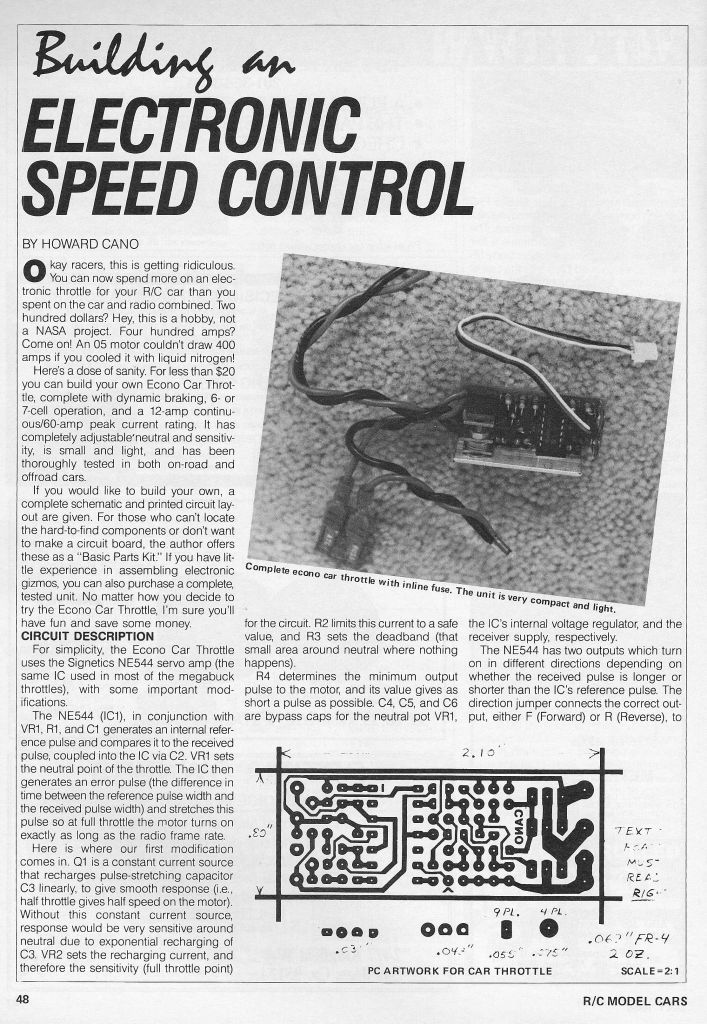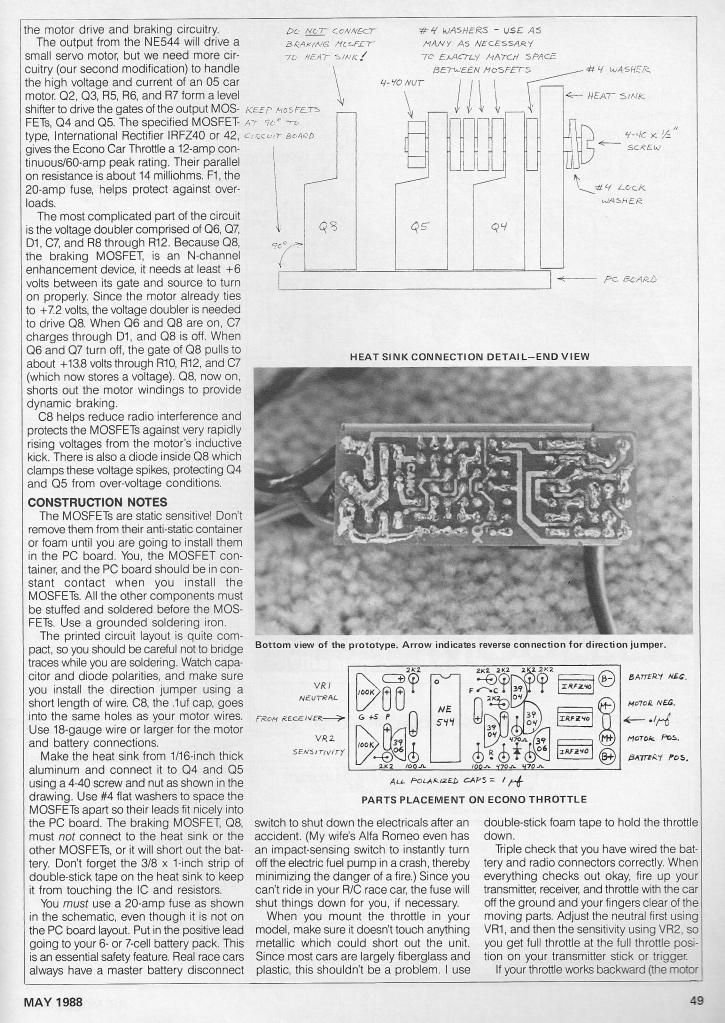can a servo be made into an ESC
#16
#17
Tech Rookie
Yes, it is in fact possible and *shock* you don't need a diploma to do it. Just a soldering iron.
Just 1)tear down the servo,
2)strip off the motor,
3) solder an h-bridge (l293d or perhaps a custom higher-current one) where the motor was,
4) replace the pot on the servo with with a rough middle-range equivalent (i.e. if it's a 1k ohm pot, replace it with a 500 ohm one. Yes, there is soldering involved. )
5) plug in your shiny new motor to the other end of the h-bridge and turn on your Tx/Rx
6) adjust your trim until the motor stops moving
If you have any experience with electronics, this shouldn't be difficult. In fact, I built a 50-amp brushed esc (using ebay components) for less than $12. Perhaps not the most reliable, but it works.
Just 1)tear down the servo,
2)strip off the motor,
3) solder an h-bridge (l293d or perhaps a custom higher-current one) where the motor was,
4) replace the pot on the servo with with a rough middle-range equivalent (i.e. if it's a 1k ohm pot, replace it with a 500 ohm one. Yes, there is soldering involved. )
5) plug in your shiny new motor to the other end of the h-bridge and turn on your Tx/Rx
6) adjust your trim until the motor stops moving
If you have any experience with electronics, this shouldn't be difficult. In fact, I built a 50-amp brushed esc (using ebay components) for less than $12. Perhaps not the most reliable, but it works.
The real problem is to make it proportional, connecting the motor will make it work 100% forward, STOP, 100% reverse, but not proportional like in a real ESC. There was a Youtube video showing a proportional set up but the guy did not tell how he did it?
#18
Tech Rookie
Hi,
I hope it's okay to wake up such an old thread. This is something that interests me, because I like micro RC models. I joined the forum just to contribute to this topic. It looks like a very interesting forum though, so I'll be back
Some servo boards/amps make quite good ESCs for cars or boats, provided the motor is smaller than the one that was in the servo - they're not normally intended to be moving continuously, so it can't necessarily drive the original motor for long, unless you're careful with the gearing, to keep the normal load quite low.
Some servo boards actually make very good ESCs, with a degree of proportionality - often enough to be useful, for a small car or boat, and not just full forward / full reverse of off. It depends on the design of the servo. Some respond to being further out of position by moving the motor quicker (that's the best sort to use), some just always move the motor at full speed (not so useful - those just act like switches).
I turned a twin motor toy boat into a proper R/C boat using the boards out of two old Futaba full sized servos. That works well, and the boards made very good proportional ESCs.
I like the idea of adding a bridge chip to boost the current output. I can see how it might turn a proportional output into a switched one, if the output of the servo board is linear, i.e. it varies a smooth current. There's a good chance that the output is PWM though, in which case it will work just fine.
I may have to do some experimenting I found a source of 5A simple single cell ESCs with reverse, recently (banggood.com), but they stopped selling them, and deleted the product page, so I may have to make my own.
I found a source of 5A simple single cell ESCs with reverse, recently (banggood.com), but they stopped selling them, and deleted the product page, so I may have to make my own.
There are plenty of small ESCs with reverse for 4xNiMH cells, or 2s lipos, but none available that I know of, for single cell lipos, or less than 4 NiMH cells.
One option is to use a 2.4GHz DSM/DSM2 DelTang receiver, which has ESCs built in - there are various models, with different numbers of ESCs. For very small models, that's a good way to go, if not a particularly cheap one. He sells add on H bridge boards, called ADD1 (800mA) and ADD2 (3A), that can be connected to them to boost the outputs. Those are quite inexpensive, for what they are.
See deltang.co.uk and deltang.co.uk/addon.htm (sorry, I'm not allowed to post them as links, yet).
I hope it's okay to wake up such an old thread. This is something that interests me, because I like micro RC models. I joined the forum just to contribute to this topic. It looks like a very interesting forum though, so I'll be back

Some servo boards/amps make quite good ESCs for cars or boats, provided the motor is smaller than the one that was in the servo - they're not normally intended to be moving continuously, so it can't necessarily drive the original motor for long, unless you're careful with the gearing, to keep the normal load quite low.
Some servo boards actually make very good ESCs, with a degree of proportionality - often enough to be useful, for a small car or boat, and not just full forward / full reverse of off. It depends on the design of the servo. Some respond to being further out of position by moving the motor quicker (that's the best sort to use), some just always move the motor at full speed (not so useful - those just act like switches).
I turned a twin motor toy boat into a proper R/C boat using the boards out of two old Futaba full sized servos. That works well, and the boards made very good proportional ESCs.
I like the idea of adding a bridge chip to boost the current output. I can see how it might turn a proportional output into a switched one, if the output of the servo board is linear, i.e. it varies a smooth current. There's a good chance that the output is PWM though, in which case it will work just fine.
I may have to do some experimenting
 I found a source of 5A simple single cell ESCs with reverse, recently (banggood.com), but they stopped selling them, and deleted the product page, so I may have to make my own.
I found a source of 5A simple single cell ESCs with reverse, recently (banggood.com), but they stopped selling them, and deleted the product page, so I may have to make my own. There are plenty of small ESCs with reverse for 4xNiMH cells, or 2s lipos, but none available that I know of, for single cell lipos, or less than 4 NiMH cells.
One option is to use a 2.4GHz DSM/DSM2 DelTang receiver, which has ESCs built in - there are various models, with different numbers of ESCs. For very small models, that's a good way to go, if not a particularly cheap one. He sells add on H bridge boards, called ADD1 (800mA) and ADD2 (3A), that can be connected to them to boost the outputs. Those are quite inexpensive, for what they are.
See deltang.co.uk and deltang.co.uk/addon.htm (sorry, I'm not allowed to post them as links, yet).
#20
Tech Rookie
Thanks very much, Howard. That's interesting stuff.
If I'd read that a few years ago, I'd definitely have made some of my own ESCs. I'm now reasonably happy with the prices of the 10A-20A ones on ebay, and the online shops of the chinese retailers, for 2s lipo brushed ESCs, but I'm still interested in the bit about how the servo amp works - I'd have more use for just that part, at the moment.
I might have a go at building an ESC with a servo board and a bridge chip that can drive a larger motor at a low voltage - without the voltage requirements in that article, which is the usual problem with them. I'd normally only need a couple of amps, probably less.
It's probably easier to just tear apart a few of my unused servos, to see which work best, rather than make one up, but it helps a lot knowing how it works.
I expect the Futaba servos I used in my little twin motor boat had that very chip - the NE544. Old servos need replacing eventually, of course, but the electronics in them are probably quite often still working.
If I'd read that a few years ago, I'd definitely have made some of my own ESCs. I'm now reasonably happy with the prices of the 10A-20A ones on ebay, and the online shops of the chinese retailers, for 2s lipo brushed ESCs, but I'm still interested in the bit about how the servo amp works - I'd have more use for just that part, at the moment.
I might have a go at building an ESC with a servo board and a bridge chip that can drive a larger motor at a low voltage - without the voltage requirements in that article, which is the usual problem with them. I'd normally only need a couple of amps, probably less.
It's probably easier to just tear apart a few of my unused servos, to see which work best, rather than make one up, but it helps a lot knowing how it works.
I expect the Futaba servos I used in my little twin motor boat had that very chip - the NE544. Old servos need replacing eventually, of course, but the electronics in them are probably quite often still working.
#21
If you are interested, here's a description of operation for a "traditional" digital-proportional servo amplifier (which are now referred to as "analog" servo amplifiers):
http://www.researchgate.net/publicat...l_Applications
They all work pretty much the same (but with differing pinouts).
If you are into microprocessors and like to fiddle, it's not terribly difficult to create an ESC using one.
http://www.researchgate.net/publicat...l_Applications
They all work pretty much the same (but with differing pinouts).
If you are into microprocessors and like to fiddle, it's not terribly difficult to create an ESC using one.
#22
Tech Rookie
Thanks, Howard. It looks like I'd have to pay to read that, but I'll have a look at the NE544 datasheet.
The problem with microcontrollers is the sheer amount of time you have to put into getting it right. Writing software takes a lot of time and effort. It's a good hobby for those who enjoy it, but I don't have much enthusiasm for it any more.
A pure hardware design can often be a lot simpler to put together, and doesn't suffer from the bugs and gotchas involved in anything computerised - if it works, it works, and it's fairly easy to check that it does. It's not likely to do something totally unexpected once in a while, or in some unforeseen circumstances, that'll have you going back to spending more hours trying to get it right.
The problem with microcontrollers is the sheer amount of time you have to put into getting it right. Writing software takes a lot of time and effort. It's a good hobby for those who enjoy it, but I don't have much enthusiasm for it any more.
A pure hardware design can often be a lot simpler to put together, and doesn't suffer from the bugs and gotchas involved in anything computerised - if it works, it works, and it's fairly easy to check that it does. It's not likely to do something totally unexpected once in a while, or in some unforeseen circumstances, that'll have you going back to spending more hours trying to get it right.










